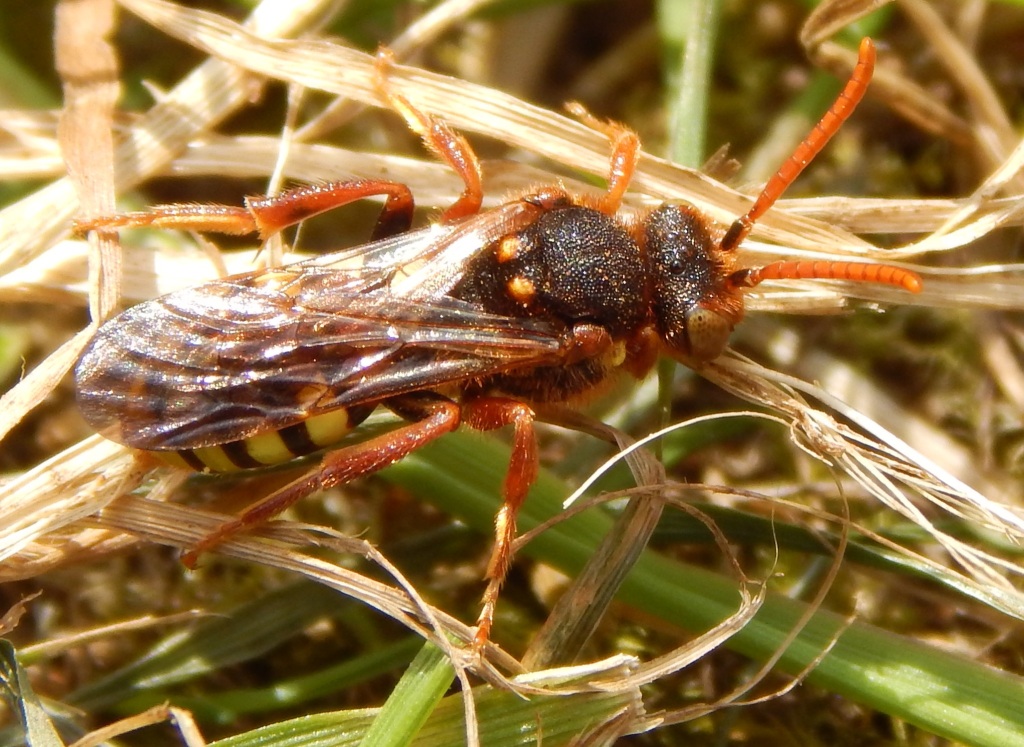
[237] Nomada Species, Nomad Bees
Introduction
The genus Nomada, generally just called Nomads or Nomad Bees (or Nomad-bees), has about 850 species of which about thirty may be found in the UK. It is one of many genera of kleptoparasitic cuckoo bees and identification to species level may be difficult.
Taxonomy
Kingdom – Animals
Phylum – Arthropods
Class – Insects
Order – Hymenoptera (Bees, Wasps and Ants)
Suborder – Apocrita
Superfamily – Apoidea
Clade – Anthophila (Bees)
Family – Apidae
Subfamily – Nomadinae (Cuckoo Bees)
Tribe – Nomadini (Single genus)
Genus – Nomada
Scientific Names – Various
Name
Nomada just means wandering or nomadic.
I can confidently say that Nomada goodeniana is named after Samuel Goodenough (1743-1827) Bishop of Carlisle and an amateur botanist, who also had a plant genus, Goodenia, and an Australian bird (Petroica goodenovii, the Red-capped Robin) named after him. In 1802, William Kirby in his book on the Bees of England said.
‘A viro Reverendo S. Goodenough, LL. D. Canonico Windsoriensi, Botanico summo tum et in Entomologia lynceo, nomen suum haec Apis mutuatur.’
As you know by now, flava means yellow.
Description
Nomada bees have bold yellow and black markings that are similar to [357] Wasps. They primarily use [024] Andrena Mining Bees as their host species but there are several other genera. The female Nomada enters the burrow under construction and lays an egg in the wall of unsealed nest cells. The first thing the larva does is to eat the host egg or larva. Then it feeds on the stored food left in the cell.
As the female bee does not provide the food for her offspring, she does not have the pollen baskets on her legs that we saw with Andrena and other bees.
I will start with some pictures that have not been identified to species level.



Nomada goodeniana
Nomada goodeniana is found all over most of Eurasia and Northern Africa, including most of England and Wales.
It has a striped abdomen. The back of the head and thorax are black, with two small yellow dots just above the wings. Its legs and antennae are orange.
I won’t go into the minute details that distinguish it from many other species of Nomada.

A broader view shows the same bee beside a hole made by Andrena cineraria.

Nomada Flava Group
The back of Nomada flava, including the two dots, is a dark red colour.

Several other species are similar, so it may be identified as Flava group.
Habitat
In theory identification to species is helped by knowing the host species.
My Field Guide to Bees suggests that Andrena cineraria may be a host to Nomada lathburiana and possible Nomada Goodeniana.
Conversely it lists three other Andrena species as the usual hosts for both Nomada goodeniana and Nomada flava.
All of my sightings and pictures come from an extensive area with hundreds of Andrena cineraria so I will stick with my usual disclaimer. None of my sightings are guaranteed to species level.
Other Notes
Kleptoparasitism (also spelled as cleptoparasatism) is very common in the Animal world and the species concerned tend to be named after the more familiar Cuckoo bird. (Cuculs canorus won’t be appearing in these blogs.)
All thirty-five species in the subfamily Nomadinae are kleptoparasites as are many other genera and species of bees and wasps. In particular the genus [052] Bombus, Bumble Bees has a complete subgenus of thirty species that infiltrate and take over the nests of other Bombus species.
